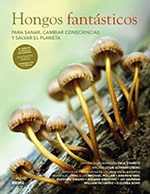In “Fantastic Mushrooms” (Blume), mycologist Paul Stamets brings together his knowledge and impressions about the world of fungi and mushrooms with leading experts. It immerses us underground in an amazing universe, crucial for life on the planet.
Text: Silvia Rinlo Photo: Blume
Paul Stamets He went out one summer morning to water his mushroom garden and observed that there were about twenty bees from their hives on the surface of wood chips. He noticed that the bees were sucking the small drops that oozed from the white threads of mycelium, the immense threads that form the networks of underground connections of the fungus. He found that there was a pilgrimage of bees day and night between the honeycomb and that field impregnated with mushroom juice. Some time ago, a friend, the environmental filmmaker Louie Schwartzberghad expressed concern about the high mortality of bees, the largest pollinators that contribute to the cycle of life, affected by the viruses transmitted to them by Varroa mites. Stamets was in a project studying fungi that reduce influenza and smallpox viruses, and thought that perhaps the bees’ instinct led them to sip this dripping of the fungal mycelium because it was beneficial to them. Four years later, that research project in collaboration with the University of Washington certified that mycelium extracts from forest polypore fungi reduce viruses that kill bees.
fantastic mushrooms It shows us a whole amazing world under our feet. In the magnificent photograph that accompanies this news, a longitudinal section of the soil shows the white threads of the mycelium, which form a complex network reminiscent of the nervous system of the human body. Mushrooms are the tip of the iceberg of that submerged world that keeps all the plant life under the forest intertwined. The ecology teacher Suzanne Simard describes it as “a vibrant network of almost microscopic threads that recycle air, soil and water in a continuous cycle of balance and replenishment.” It explains how fungi, with their enzymes, carry out the process of decomposing wood and absorb its nutrients, a part of which can become nutritious mushrooms.
Tradd Cottermicrobiologist and mycologist, explains that fungi are the glue in the kingdoms of life, which include insects, plants and animals. They make nutrients bioavailable to other organisms.
 Paul Stamets insists that “the history of fungi is the history of our essential unity.” It tells us that everyone is looking above ground for solutions to our environmental problems, but we can find some in fungi to address many of the challenges we face. The first lesson of fungi is that they work in symbiosis and in a collaborative network with trees, insects and forest organisms. Mycorrhizal fungi establish relationships of mutual survival with trees. The fungus absorbs nutrients from the soil that the tree is not able to process and transfers them to its roots. In exchange, the tree provides the fungus with sugars. Fungi absorb a very important part of the CO2 that plants capture during photosynthesis (and create the dreaded greenhouse effect) and lock it underground.
Paul Stamets insists that “the history of fungi is the history of our essential unity.” It tells us that everyone is looking above ground for solutions to our environmental problems, but we can find some in fungi to address many of the challenges we face. The first lesson of fungi is that they work in symbiosis and in a collaborative network with trees, insects and forest organisms. Mycorrhizal fungi establish relationships of mutual survival with trees. The fungus absorbs nutrients from the soil that the tree is not able to process and transfers them to its roots. In exchange, the tree provides the fungus with sugars. Fungi absorb a very important part of the CO2 that plants capture during photosynthesis (and create the dreaded greenhouse effect) and lock it underground.
The book also delves into those antennas of the underground world that are mushrooms. Their origin underground, in those very complex exchanges of nutrients, sugars and substances, makes them unique. Stamets, one of the people who knows the most about the subject, tells us that “mushrooms are a mystery.” He tells us about the different types, their cultivation, their therapeutic and also psychedelic applications. Since the dawn of time, shamans and those who have wanted to connect with the sacred have turned to hallucinogenic mushrooms in a relationship between chemistry and consciousness about which we still do not know much. The story of medical experiments with psilocybin extracted from mushrooms is surprising, and its use is considered to be very important in the coming years in treatments against depression and anxiety. Mary Cosimanowho has been working for years in the Johns Hopkins Foundation In experiments with psilocybin with volunteers, he explains that they combine its administration with listening to soft music so that they work together in the mind. He says that what happens “is difficult to explain in words. With almost every volunteer we travel with, something primal and beautiful emerges.”
#Antennas #hidden #world #Librujula


